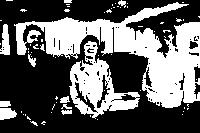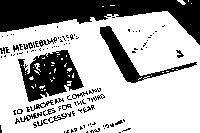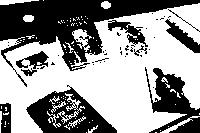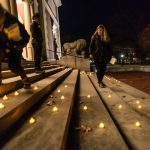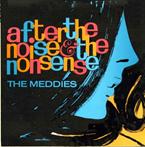 The Meddiebempsters, reputedly the country’s third-oldest all-male a cappella group and certainly Bowdoin’s oldest group, has been singing in harmony for almost 19 generations of college students, if a generation is counted once every four years.
The Meddiebempsters, reputedly the country’s third-oldest all-male a cappella group and certainly Bowdoin’s oldest group, has been singing in harmony for almost 19 generations of college students, if a generation is counted once every four years.
To celebrate the Meddiebempsters’ 75-year anniversary, the Bowdoin’s Hawthorne-Longfellow Library has created a new interactive exhibition on the group, Do Re Mi. The exhibition will be up through Dec. 21.
More than offering just Meddiebempster history, however, Do Re Mi also includes a display on the broader history of music at Bowdoin, helping prove why it was once dubbed a “singing college.”
(Meanwhile, Special Collections Director Richard Lindemann has set up a second simultaneous exhibition, A B C, featuring the library’s collection of old or artistic writing and alphabet books. See the sidebar for more information.)
The books range in date from 1763 (although they include a facsimile from the 15th century) to 2012. They include playful books for children, as well as books crafted as works of art.
Alphabet books and writing books emerged during the late Middle Ages to advance literacy skills. Alphabet books helped children learn to read, while writing books focused on the shape and technique for forming letters. Together, these two genres “show how utilitarian books can be, and can become, objects of beauty, to be admired as much as to be read,” Richard Lindemann writes in the exhibition’s introduction.
Meddiebempster fans should make their way to the library’s second floor gallery, where a long glass case encloses some of the Meddies’ sheet music, albums, photographs and ephemera that Marieke Van Der Steenhoven, Bowdoin’s Special Collections & Archives assistant, retrieved from College archives.
The exhibition outlines the history of the group, including notable performances and concerts in front of VIPs, such as first lady Bess Truman and Supreme Court Justice Harold Burton, ’09. It also explains the origin myths of the group’s unusual name (a map of Maine, a thrown pencil, and the town of Meddybemps may all have played a part).
The exhibition will soon include an iPad programmed with many of the group’s recordings over the years, including “Mood Indigo,” a Duke Ellington tune the Meddies have been singing since 1937. Beyond this, the listening station will feature a variety of music representing different parts of Bowdoin’s musical past.
The remainder of the exhibition has been devoted to the history of music at the College, both in academics and in student extracurricular life. It was curated by Karen Jung, Bowdoin’s music librarian, and Caroline Moseley, the library archivist.
The exhibition piece focusing on Bowdoin’s extracurricular music scene includes mementos of the old Glee Club (phased out when co-education was established here), an interfraternity singing competition, and some history on “Raise Songs to Bowdoin,” the alma mater originally known as “Rise, Sons of Bowdoin.”
The other part of the exhibition portrays the past century of music scholarship at Bowdoin. “There was a lot of extracurricular music at Bowdoin, but it was not until 1913 when Bowdoin brought music into its academic curriculum,” Jung explained.
In the beginning, just four courses were offered on music history and theory. Prof. Frederic Tillotson, appointed head of the music department in 1936, did much during his tenure to strengthen Bowdoin’s music department and culture. Among other things, he helped form the Meddiebempsters; he also started the tradition, still going strong today, of hosting both guest artist and student recitals. “Tilly [as he was called by many] thought students should show off their work,” Jung said.
Today, as the music department approaches its 100th anniversary, its curriculum includes courses on early music, jazz, ethnomusicology or world music, popular music and hip hop. The College offers the annual Bowdoin International Music Festival and the Charles E. Gamper Festival of Contemporary Music, and has two buildings devoted to music performance and practice: the Harvey Dow Gibson Hall, built in 1952, and the Studzinkski Recital Hall and Kanbar Auditorium, completed in 2007. But music happens all over the campus: the Chapel, Moulton Union lounge, Kresge Auditorium, Pickard Theater and the Quad – just to name a few spots.
һӻ
“¬